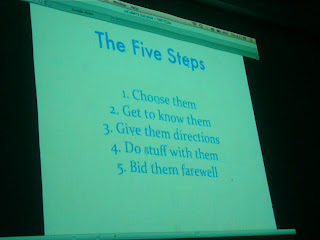While in Chicago, Billy suggested that we visit the public library building. Being the stubborn pragmatist that I am, I wasn’t sure what his excitement about this was, seeing as we weren’t going to be in town long enough to check out books, but I went along for the ride.
After listening to a blues band play in the basement, and riding the escalators for a while, Billy recalled a talk that Marc Fischer gave last fall at PSU regarding the Temporary Services project wherein the group added 100 artist books to the library collection without alerting the librarians to their plans. TS adhered numbers on spines of the books, manila cardholders on the interior sleeves, and other Chicago Public Library stamps and markings in the appropriate locations. According to Marc, one of the librarians has begun to collect the books and store them in a special location somewhere in the library. We decided to go on a treasure hunt for the collection.
I started our search on the wrong foot by asking a woman on the Literature Floor whether or not she was aware of a collection of artist books being stored in the library. Our interaction was very similar to a Monty Python sketch, in that she immediately asked me whether I was talking about paintings or sculpture. When I told her that I was actually looking for books, artist books, repeatedly asked, “Paintings?” I tried a different tack and said that no, I was looking for books made by artists, and that the books were the art. She said, “You mean paintings. Or sculpture, maybe? …are you talking about literary arts?” This went on for a while, with her eventually stating that unless I was looking for the literary arts, I should go upstairs to the Fine Arts and Performance floor and ask there.
We were sent on a brief visit to special collections on the 9th floor,
back down to the Fine Arts section and finally were allowed behind the “Staff Only” doors into the Arts Reference room. In a file cabinet in a bottom corner, we found books containing books, books that were actually hats, pants and jackets, books made of salt and plaster, and a variety of other lovely treats. Next time you’re in Chicago, check this out!



